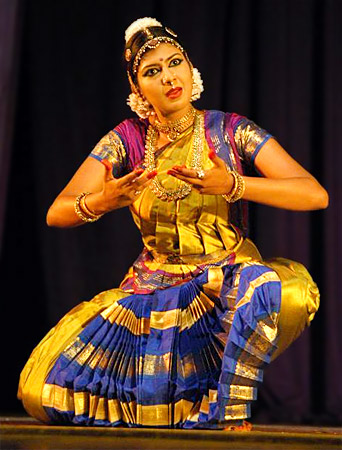 Varnam is one of the major complicated elements of Bharatnatyam which allows a dancer to improvise as required. The dancer begins by presenting cadences of tirmanams, with a repetitive line of a song being played. These tirmanams are woven in three tempos. This makes the dance composition more elaborate. In the beginning there should be synchronization between the dancer, the singer and the drummer. The Varnam has an architectonic structure due to the levelled layers of the musical theme. This diversification in the musical phrase leads to a final synchronization when the end of the tirmanam coincides with the first note of the song.
Varnam is one of the major complicated elements of Bharatnatyam which allows a dancer to improvise as required. The dancer begins by presenting cadences of tirmanams, with a repetitive line of a song being played. These tirmanams are woven in three tempos. This makes the dance composition more elaborate. In the beginning there should be synchronization between the dancer, the singer and the drummer. The Varnam has an architectonic structure due to the levelled layers of the musical theme. This diversification in the musical phrase leads to a final synchronization when the end of the tirmanam coincides with the first note of the song.
The beginning of each Nritta sequence is denoted by constantly stamping the feet which maintains the inner beat of the time cycle. Simultaneously the drummer prepares through a particular rhythmic sequence for the next sequence. The combination of the toe-heel pattern with miming is the most challenging part of the varnam. The last part of varnam is known as the charanam. The abhinaya is performed first to the song and then to the Nritta sequences. The literary content of this musical composition describe many facets of God. In the last part or the charanam, the devotee`s yearning for the god is described vividly. The mood is slowly built up but once the dancer reaches crescendo, it communicates a deep feeling of faith and adoration.
As far as technique is concerned, the dancer has freedom to improvise on the musical note and on the literary word. In the abhinaya portions, the dancer presents either a word to word interpretation or renders through gesture the meaning of a complete line. The imaginative faculty of a dancer is exposed through Varnam. Thereby the dancer should possess a rich literary background. Dancer executes abhinaya portion with the aim of evoking Sthayi bhava. This is developed by presenting sancharibhavas. In the Nritta portions as well, the dancer has freedom within the limitations which she sets for herself. She improvises on the svara patterns. The tirmanams of the varnam differ from those of the Jatisvaram which precede it and those of the Tillana which follows it.



















